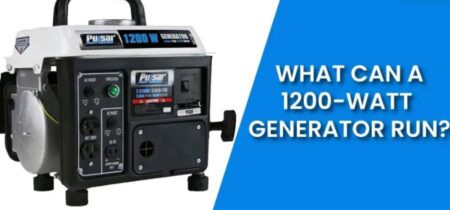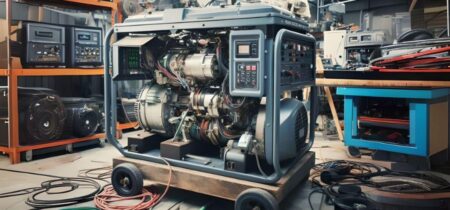
The battery in a generator is the foundation of its functioning and it would be just a rugged machine, otherwise, how will you even get it going? They store energy to ensure the smooth operation of the equipment they serve — allowing a generating set to work normally even when disconnected from the mains. Batteries provide power for both passive and active functions in generating sets, eventually enabling the conversion of alternating and direct current.
If a generator’s battery explodes, it can cause significant damage, so prevention involves regular maintenance and monitoring. This article will cover these aspects in detail.
How to Determine the Power Requirements of Your Generator and the Battery?
If you like to calculate the power requirements of your generator, you need to first check the Wattage and Horsepower of Your Generator. Here’s how to do so:
Identify Appliances and Systems: Make a list of the appliances and systems you want to power during an outage or in areas without standard electrical service.
Calculate Total Wattage: For each appliance with a motor, use the formula: Running wattage (R) + Starting wattage (R x 3) = Total wattage needed. For items without motors, only consider the running wattage.
Add Up the Total Wattage: Once you have the wattages for all the appliances, add them together to determine the total wattage needed.
Consider Surge Capacity: Look for the surge capacity, especially for motor-driven items which is usually the starting wattage multiplied by three.
Select the Right Generator Size: Choose a generator that can provide at least the total wattage needed, including the surge capacity. Choosing a Battery for Your Generator Now onto the meaty part: the selection of battery. Here’s how you should do it
Calculate Battery Requirements: Determine the starting and running wattage of your generator. Choose a battery that can handle the starting and running wattage of your generator.
Consider Battery Type: Select a battery type that can provide the required power output and has the necessary capacity to support the generator’s operation.
Whenever you’re checking the wattage and horsepower of your generator, calculate the total wattage needed as well as the surge capacity to make sure that the generator can meet the power requirements of your appliances/systems.
If the power requirement is given in amps, you can multiply the amps by the voltage to derive the required wattage.
How to Compare the Different Categories and Types of Batteries for Generators
In order to select appropriate batteries for the generator, you need in-depth knowledge about the various types available as well as the corresponding advantages and disadvantages.
● Lead Acid Batteries: They’ve dominated the market, particularly on emergency and standby power. These batteries are available in differen designs that include flooded, gel, and AGM (Absorbed Glass Mat) and will stay fully charged for a long time Nonetheless, they are quite heavy and cumbersome to carry around for transport of any distance at all. However, maintaining adequate electrolytes is a regular and easy-to-do task.
● Lithium-Ion batteries: These batteries possess the highest power-to-weight ratio. Light and small in weight as compared to the lead-acid battery with the same size capacity of about 20-30%. They have safety protection on them hence ideal for standby generators with a high cycle life. This, however, comes at a cost – each such equivalent capacity battery costs approximately two times more than the lead-acid analog.
● AGM Batteries: these are also used in emergency and standby power are easy to carry, and can remain charged for a long span. One disadvantage of these batteries is their heavy nature. The batteries need high-quality battery chargers because they tend to discharge themselves if not adequately charged.
● Gel batteries have numerous similarities with flooded lead acid batteries except that they are sealed and can no longer be recharged. In most cases, they are smaller and are generally used to feed limited loads such as yard security lighting. However, they are relatively more massive than other forms and difficult to transport.
When purchasing a battery for your generator, compare these options by considering their costs, weight, amount of maintenance needed, as well as application-specific details. That’s why I lithium-ion as it can be the right option. Even though it’s rather expensive but portable and demands minimal maintenance or recharge.
How to Select the Best Battery for Your Generator?
When selecting the best battery for your needs and preferences to fuel generator, consider the following criteria:
Primary vs. Secondary: Determine if your application requires primary (single-use) or secondary (rechargeable) batteries.
Energy Density: Evaluate the energy density, which is the potential energy available relative to the overall weight of the system. High energy density implies high potential energy with a low amount of weight.
Battery Capacity and Voltage: Consider the battery capacity, measured in milliampere-hours (mAh), and voltage, which varies based on the materials used for the electrodes. For instance, lithium batteries range from 3.2 to 4 V, while others range from 1.2 to 2 V.
Cold Cranking Amps (CCA): For applications like starting a car engine, consider the CCAs, which indicate the battery’s power output speed in cold temperatures. This is critical because engines are more challenging to start in the cold.
Operational Requirements: Look at the operational temperature range, service life (the length of time operation is required), physical requirements like size, shape, and weight, shelf life (allowable storage time), and the charge-discharge cycle, including discharge profile and charging efficiency. These criteria help ensure that the battery you select is well-suited to your specific requirements and application.
How to Install, Maintain, and Replace Your Generator Battery
Installing, maintaining, and replacing a generator battery requires several steps to ensure optimal performance and reliability.
Installation
Before installing the generator battery, always refer to your owner’s manual for details. In general, an air-cooled generator must be unlocked using a key, and the generator needs to be switched off as well as detached from any energy source prior to installation. When installing for real, position the battery in the compartment and properly connect the terminals, ensuring correct alignment (plus to plus, minus to minus). Check voltage and current compatibility upon installation with a view not to destroy the generator.
Maintenance
You need to conduct regular maintenance if you want to have a good generator battery. A trickle charger can be used to maintain the battery’s charge (this charging is very slow), protecting the battery against too much charge or not enough charge. The battery’s terminals need to be cleaned of corrosion and kept clean at all times since corrosion may slow down the charging process and general performance of the battery. It is vital to watch out for any changes in a battery’s charge by constantly checking the battery’s charge status by using an indicative light on a charger in order to prevent overcharging and to preserve the battery’s life span.
The battery of a generator should be changed or recharged after 2-4 years based on frequency of use and to maintain effectiveness. One should also monitor the integrity of batteries at least once a month to notice early occurrences of any problematic issues.
Replacement
Replacement is done in time only by identifying a failing battery. A dead battery is represented by a non-starting generator, battery corrosion, or significantly lower voltage readings than the rating of the battery. If the battery has been drained, use a trickle charger or try jump-starting using a car and jumper cables. Nevertheless, once discharged beyond a particular level, the battery may not be able to recharge, and new ones must be purchased in this case. Since this requires some time, you should verify whether the battery has a warranty or not. When replacing the battery, follow the same steps as for installation to ensure the new battery matches the generator’s specifications.
How to Prevent and Avoid Battery Explosions?
Before we dig into the mitigation of battery explosions, let’s find out why they occur especially on lithium-ion battery cells. One of the most possible reasons behind this includes “thermal runaway” — a chain reaction that may end up in excessive heat, fire, and even explosion collapse. This is likely due to high power flows, especially after quick charge cycles. The study showed that large local currents within a rested battery after a fast charge may lead to a thermal runaway.
A major part is the anode component which is usually composed of graphite. Lithium ions are integrated smoothly into the graphene sheets as it is charged slowly. However, rapid charging may promote the formation of dendrites and lithium is prone to forming dendrites. Dendritic deposits are unstable and may result in battery failure.
Battery explosions have dire consequences. They are also hazardous since they create fires and injure people. In addition, these materials affect the natural environment. Such as open pit mining or brine extraction causes mineral extraction that results in erosion, pollution, and water depletion. Moreover, unused batteries are thrown away causing soil and water pollution and risking fires in dump-sides too.
How to Prevent Battery Explosion?
Therefore, some preventive steps will be suggested in order to minimize these risks. Sprinkler systems are installed as control measures against fire outbreaks from battery explosions. Correct storage temperatures are of significance as they help avoid extreme battery generation of heat and explosions. It is also important to use the recommended charger from the manufacturer because this is usually the reason for battery explosions. However, frequent supervision of charging batteries and time-to-time replacement of battery cells may also be helpful in minimizing such dangers.
Conclusion
You should accurately calculate power requirements and match the battery to your generator’s needs for safer and more efficient generator use. Choose between lead-acid, lithium-ion, AGM, or gel batteries based on budget and operational demands. Lithium-ion is efficient but costly; lead acid is cheaper but needs more maintenance. Regular maintenance, proper installation, and abiding by the safety guidelines will aid in preventing battery explosions. Always use the recommended charger and replace batteries as needed to ensure longevity and safety.
Frequently Asked Questions
What is the life expectancy of a generator battery?
The life expectancy of a generator battery typically ranges from 2 to 5 years. The specific lifespan depends on usage, maintenance, and storage conditions. Regular maintenance and proper storage can help prolong the battery’s life.
Why do batteries explode when overcharged?
Batteries, particularly lithium-ion batteries, can explode when overcharged due to overheating and internal short circuits. Overcharging can cause the formation of metallic lithium on the battery’s anode, leading to these dangerous conditions.









